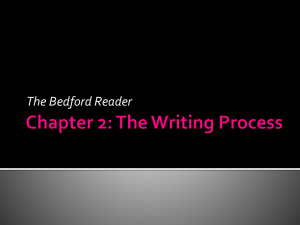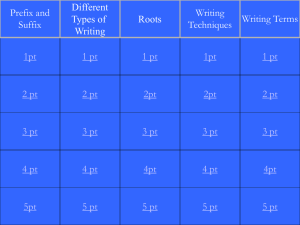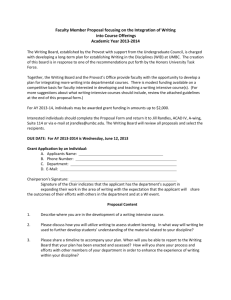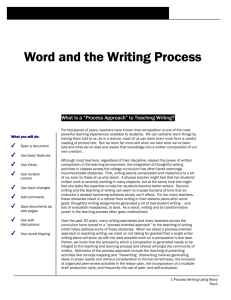Developing Independent Writers
advertisement
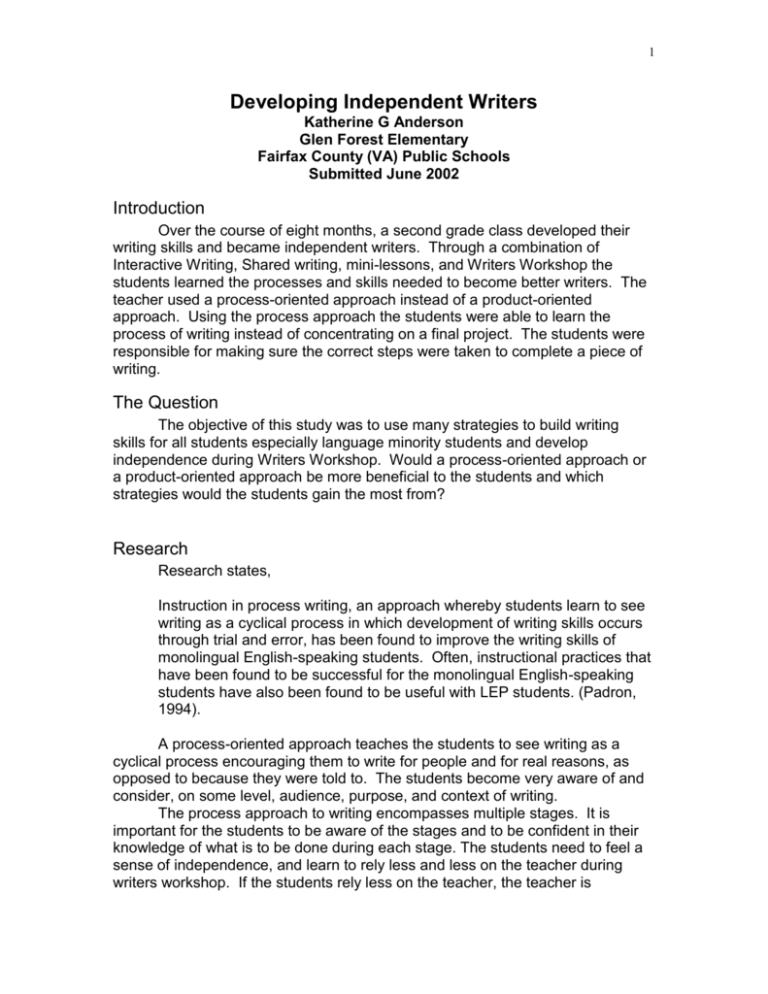
1 Developing Independent Writers Katherine G Anderson Glen Forest Elementary Fairfax County (VA) Public Schools Submitted June 2002 Introduction Over the course of eight months, a second grade class developed their writing skills and became independent writers. Through a combination of Interactive Writing, Shared writing, mini-lessons, and Writers Workshop the students learned the processes and skills needed to become better writers. The teacher used a process-oriented approach instead of a product-oriented approach. Using the process approach the students were able to learn the process of writing instead of concentrating on a final project. The students were responsible for making sure the correct steps were taken to complete a piece of writing. The Question The objective of this study was to use many strategies to build writing skills for all students especially language minority students and develop independence during Writers Workshop. Would a process-oriented approach or a product-oriented approach be more beneficial to the students and which strategies would the students gain the most from? Research Research states, Instruction in process writing, an approach whereby students learn to see writing as a cyclical process in which development of writing skills occurs through trial and error, has been found to improve the writing skills of monolingual English-speaking students. Often, instructional practices that have been found to be successful for the monolingual English-speaking students have also been found to be useful with LEP students. (Padron, 1994). A process-oriented approach teaches the students to see writing as a cyclical process encouraging them to write for people and for real reasons, as opposed to because they were told to. The students become very aware of and consider, on some level, audience, purpose, and context of writing. The process approach to writing encompasses multiple stages. It is important for the students to be aware of the stages and to be confident in their knowledge of what is to be done during each stage. The students need to feel a sense of independence, and learn to rely less and less on the teacher during writers workshop. If the students rely less on the teacher, the teacher is 2 available to walk around to room, stopping at a few desks, discussing topics and stories with the students. After the teacher has done this he/she is able to devote much of his/her attention to conferencing with a student. The students and the teacher all work together as one group. The teacher, in this setting, is not the director of writing. Students learn to look to, not only the teacher, but to other students for support. Native speakers of English and second language learners can depend on each other. Samway states, Even while they are in the process of acquiring English, children are budding teachers and can provide considerable support to each other by offering feedback, seeking feedback on their own writing, and sharing their success and difficulties as writers. In addition to being responsible for their own writing, students are also responsible for helping each other grow as writers” (Samway, 1992). “The teacher, however, is the head teacher, as well as a fellow writer and mentor.” (Samway, 1992) Students The students in this study were second grade students in the researchers’ class at Glen Forest Elementary School. The class is composed of twenty-two students from many different countries. Twelve of the twenty-two students were second language learners and all of the students writing levels varied greatly. Most of the students were verbally comfortable with the English language but dreaded writing the language. Program At the start of the school year, the teacher recognized that the writing skills and the independence of her students were very low especially that of the second language learners. The teacher wondered what could be done to get the most improvement within the school year. Many of the teacher’s more experienced team members were trying to build writing skills using retellings. She decided that she would take the advice of her colleagues and tried retellings with her class. She read many different books and had the students retell all the stories multiple ways. The teacher quickly realized that this approach to building writing skills was not effective for her particular class. She quickly changed to a combination on mini-lessons, Shared Writing, Interactive Writing, and Writers Workshop. She saw that the students were unable to take the proper steps in writing because they were unaware of the writing process. Being unaware of the process, the students were struggling to get anything on paper. Through many different strategies the teacher decided on a process-oriented approach as opposed to a product-oriented approach. This approach was combined with other strategies including mini lessons, Shared Writing, and Interactive Writing. Early in the year, Shared Writing and Interactive Writing were the most beneficial for the students. As the school year went on the teacher began to use instruct through mini lessons which the students benefited from more. 3 Writers Workshop was first introduced by a game board mounted on the wall. The game board was titled Our Writing Game. The game was made up of eight pieces. The pieces were labeled start, planning, draft, peer conference, revise, edit with the teacher, final, and finish. All of the students had a clothes pin with his/her name on it. The clothes pins got moved through the game as needed. Through mini-lessons, the students were taught what each step of the game meant. They were taught, and they learned, multiple strategies for planning, including drawing a picture, webbing, talking with peers, and planning a beginning, middle, and end. They learned that drafts were not going to be perfect. They learned to cross out from and add large parts to their work. The students learned to peer conference by first conferencing with the teacher on a story she wrote. By doing this, they learned what questions they need to ask as a reader and as a writer. They learned that revising was not correcting only spelling, capitalization, and punctuation, but was actually adding and removing whole parts of their work. During an interactive writing lesson, the teacher discussed with her class, and made a list of, strategies that good writers use. The students and teacher together decided on the list of things that the students would remember to use as they were working on a story. They learned that once they had written something it was not set in stone. They could change a piece of work as many times as they needed, which meant that their clothes pin could move backwards and forwards in our game. Five minutes at the end of each day was set aside to make sure that every students’ cloths pin was at the stage it needed to be for the next day. The teacher kept a grid of where the students were on a daily basis. This ensured that each student was continuing to work. No student could stay in one place for an extended period of time. The students only published one piece of work each quarter so as not to put too much emphasis on the final products. They started many things that were never finished because they lost interest or they realized they were writing for themselves and not for an audience. These skills provided a positive step to developing writing skills. Another positive result that this process approach developed was independence. The teacher was not the director in the students writing. The students learned to discuss their ideas with classmates, parents, and other people. They also learned to look to books as a source of ideas. The teacher played only a small role in the initial stages of writing. She spent time every day walking around discussing topics, stories, and what good writers do with the students, but the students knew that she was not the only resource to look to for help. The increased communication among the students also built a strong sense of community. The teacher was not always the go between for the class. As a final activity, the students chose their favorite piece and publish it. The teacher took little responsibility for the finalization of these pieces. The students were given a deadline, months ahead. They were then able to go the computer lab and type their work. After they typed their work they were able to illustrate the story and present it to the class. 4 Results From the study in the teachers’ classroom, a process-oriented approach had a very positive impact on student performance and independence. The teacher observed many students discussing ideas and concerns with other students instead of coming to the teacher. There was a newfound sense of freedom with the students in their writing. One student tried a new approach that had not been introduced to the class. He was an excellent artist and dreaded writing. To balance his skills he decided to create a picture book and then add the story. For this particular student the difference in his writing was amazing. He had gone from struggling to get two to three sentences on a page to creating an entire book. His writing had gone from short “I like….” sentences to a book with a beginning, middle, and end, with characters and a setting. Upon completion of his book, the teacher saw in his face a feeling of success she had never seen from this student before. The classroom atmosphere became an environment in which everyone depended on each other. The students learned to enlist the help of other resources including other students. Working through writing difficulties was no longer a teacher-student problem it was a student-class problem. The students learned that if one classmate could not help then they should ask another. 12 10 8 Fall 6 4 2 0 Spring No vic e Ap pr en t ic e De ve lo pi ng In de pe nd en t Ex pa nd in g Number of Students Comparision of Writing Levels Writing Levels Conclusion Over the course of the eight months, this project showed that using a process-oriented approach improved the writing skills of the students, especially those of the second language learners. This approach to writing taught the students that writing was a cyclical process. The students learned to continue writing and revising until they came to the final product that they were proud of. 5 Students in this study worked together with the teacher to develop a collaborative atmosphere, in which the class worked through their difficulties in writing as a group instead of as individual units. The use of a process approach in this multicultural classroom has shown that a process-oriented Writers Workshop develops writing skills and independence and should be incorporated into multicultural classrooms. References Bergin, Jeannine and Georgia Portocarrero. (1997). Developing Literacy: A CoTeaching Model Using Readers’ and Writers’ Workshop. Presented at meeting of the Teachers of English to Speakers of Other Languages. 1997: 12p. Clair, Elizabeth. (1982). A Writing Program for Elementary-Aged Children Who Have English as a Second Language. Knudson, Ruth. (1990 Oct). A Question for Writing Teachers: How Much Help Is Too Much? English Journal 79 (6), 91-93. Padron, Yolanda N. and Laurie R. Weaver. (1994). Writing Instruction for Limited English Proficient Students: A Survey of Teachers’ Perception. Presented at National Association for Bilingual Education Conference. 1994: 15p. Samway, Katharine Davies. (1992). Writers’ Workshop and Children Acquiring English as a Non-Native Language. Suleiman, Mahmoud. (2000). The Process and Product of Writing: Implications for Elementary School Teachers. Presented at California Association for Bilingual Education Conference. 2000: 11p.



